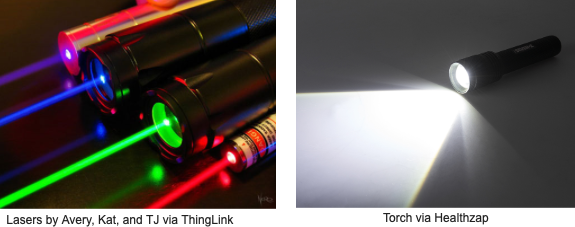Laser: Light that Burn
- Kai Xiang Lee
- 3 min read
Fields covered: Physics, Light, Energy, Lasers
Related article: Lasers
The successful warrior is the average man with laser focus – Bruce Lee
LASER: Light Amplification by Stimulated Emission of Radiation. Lasers find uses in every corner of our world, from manufacturing in the semiconductor industry to surgical applications in the medical field, and can even be found in barcode scanners. But what exactly are lasers, and how do they work?

A laser produces a highly collimated and monochromatic beam of light. Let’s break this down. A collimated beam does not spread out as it travels. Consider a regular torch – the spot size of the light spreads as you shine it at distant objects. A monochromatic beam only comprises light of a single color. Normal sunlight that we see has light of many different colours. This is what gives us our golden sunsets but crystal skies. A laser produces light with these special qualities. How do they do it?
Lasers are built using four main components: A gain medium, an energy pump, an optical resonator, and a focusing lens.
- Gain medium: A substance that can exist in several energy levels. Could be a crystal, a diode, or even a gas.
- Energy pump: Used to supply energy to the gain medium.
- Optical resonator: Used to contain the light and build up power. Mirrors are typically used, with one side half-coated to let some light out.
- Lens: Used to direct the beam in a single direction, making it highly collimated.
The energy pump energises the gain medium, bringing it to a higher energy level. It then falls back down into a lower energy level, releasing light. The light bounces back and forth in the optical resonator, before escaping and getting focused by the lens.
But this isn’t all! If you look at a laser, you will immediately notice how bright it is. Some other effect is at play here, to build up the power of the laser. Stimulated emission occurs when a passing beam of light disturbs the gain medium. It causes the medium to return to the lower energy level, and releases an identical beam. This means that the longer light remains trapped between the mirrors, the more times it passes the gain medium, and the higher the intensity of the beam.
This allows us to build strong lasers, which gives us more precise control over light. We can use light with these laser properties to perform delicate tasks, such as accurate scanning of barcodes, cutting of tissues in surgery, or communications in fibre optics.
Lasers are immensely useful tools that we unknowingly use every day. We should take the time to step back, and appreciate the novel phenomena that allows it to work.




